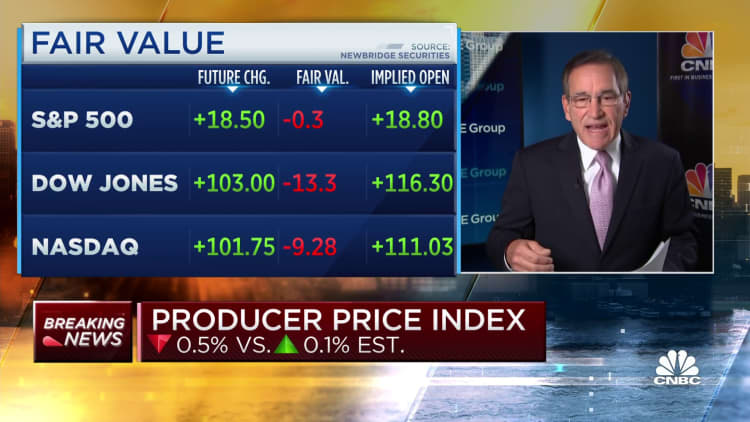Wholesale prices fell 0.5% in October for biggest monthly drop since April 2020

Wholesale prices in October posted their biggest decline in 3½ years, providing another indication that the worst of the inflation surge may have passed.
The producer price index, which measures final-demand costs for businesses, declined 0.5% for the month, against expectations for a 0.1% increase from the Dow Jones consensus, the Labor Department reported Wednesday. The department said that was the biggest monthly decline since April 2020.
On a yearly basis, headline PPI posted a 1.3% increase, down from 2.2% in September.
Excluding food and energy, core PPI was unchanged, also below the forecast for a 0.3% increase. Excluding food, energy and trade services, the index increased 0.1%.
The report comes a day after the Labor Department said the consumer price index, which measures prices for goods and services at the consumer level, was unchanged in October from the previous month. That set off an aggressive rally on Wall Street, where sentiment is rising that the Federal Reserve is done raising interest rates and could in fact start cutting in the first half of 2024.
However, consumers in October displayed some sensitivity to prices.
The Commerce Department’s advance retail sales report for the month showed a decline of 0.1%, according to a number that is adjusted for seasonal factors but not inflation. Wall Street had been looking for a drop of 0.2%. Excluding autos, sales rose 0.1%, compared with expectations for an unchanged number.
Price declines came primarily from the goods side, as the index slid 1.4%, according to the PPI report. Final demand services prices were unchanged. A spike in goods prices caused by outsized demand for big-ticket items in the early days of the Covid pandemic helped fuel the inflation surge.
Some 80% of the drop in goods prices came from a 15.3% tumble in gasoline prices, the Labor Department said.
On the services side, transportation and warehousing costs increased 1.5%, while trade services declined 0.7%. Airline passenger services prices increased 3.1%.
From the consumer standpoint, sales also were held back by the decrease in gasoline prices, with sales at service stations down 0.3%, the Commerce Department reported. Motor vehicles and parts dealers saw a decline of 1% while furniture and home furnishing stores reported a 2% drop. Both food and beverage and electronics and appliance stores showed increases of 0.6%.
The control group of retail sales that the Commerce Department uses to compute gross domestic product showed a 0.2% gain.
Stock market futures held positive following the report while Treasury yields also were higher.
In other economic news, the Empire State Manufacturing Survey, which gauges conditions in the New York area, posted an unexpected increase of 14 points to 9.1, better than the estimate for a -3 reading. The number represents the percentage of companies seeing expansion against contraction, so any positive number indicates growth.
The report, from the New York Federal Reserve, showed gains in inventories and shipments, while the indexes for employment, prices and unfilled orders fell.
Correction: Wholesale prices in October posted their biggest decline in 3½ years. An earlier version misstated the time frame.
